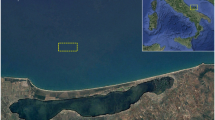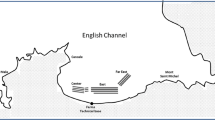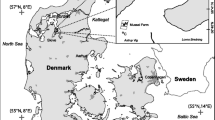Abstract
To assess the potential of the bearded horse mussel (Modiolus barbatus) and Noah’s Ark shell (Arca noae) for aquaculture in southern Croatia, we analyzed their survival and growth rates under two experimental conditions—suspended culture and on-bottom culture. Furthermore, we investigated feeding on zooplankton by these two species in suspended culture conditions and compared them with previously published results of their feeding on zooplankton in the natural benthic environment. Experimental studies were conducted in Mali Ston Bay (Adriatic Sea) from December 2009 to December 2010. Differences were observed in terms of survival of tagged M. barbatus and A. noae—specimens of M. barbatus exhibited much better survival rates both in suspended culture and in on-bottom cages than did A. noae. Growth of A. noae under both culture conditions was essentially negligible, while M. barbatus grew several times faster in suspended culture than on the bottom. Values for the growth constant K and L inf for M. barbatus in suspended culture were 0.45 year−1 and 55.9 mm, while corresponding values for on-bottom culture were 0.09 year−1 and 58.6 mm, respectively. Zooplankters were present in the stomachs of 86.3 % of M. barbatus and 86.4 % of A. noae. Most abundant taxa were bivalve larvae followed by tintinnids, copepods, unidentified eggs and gastropod larvae. In conclusion, this study clearly shows that M. barbatus is a promising candidate for suspended aquaculture in southern Croatia.







Similar content being viewed by others
References
Alfaro AC (2006) Evidence of cannibalism and bentho—pelagic coupling within the life cycle of the mussel, Perna canaliculus. J Exp Mar Biol Ecol 329:206–217
Anestis A, Pörtner HO, Lazou A, Michaelidis B (2008) Metabolic and molecular stress responses of sublittoral bearded horse mussel Modiolus barbatus to warming sea water: implications for vertical zonation. J Exp Biol 211:2889–2898
Benović A (1997) The history, present condition, and future of the molluscan fisheries of Croatia. In: MacKenzie CLJr, Burrell VGJr, Rosenfield A, Hobart WL (Eds) The history, present condition, and future of the molluscan fisheries of North and Central America and Europe. NOAA technical report NMFS 129, vol. 3, Europe. U.S. Department of Commerce Seattle, pp 217–226
Clarke KR, Warwick RM (2001) Change in marine communities: an approach to statistical analysis and interpretation, 2nd edn. PRIMER-E Ltd, Plymouth
Davenport J, Smith RJJW, Packer M (2000) Mussels Mytilus edulis: significant consumers and destroyers of mesozooplankton. Mar Ecol Prog Ser 198:131–137
Davenport J, Ezgeta-Balić D, Peharda M, Skejić S, Ninčević-Gladan Ž, Matijević S (2011) Size-differential feeding in Pinna nobilis L. (Mollusca: Bivalvia): exploitation of detritus, phytoplankton and zooplankton. Est Coast Shelf Sci 92:246–254
Ezgeta-Balić D, Rinaldi A, Peharda M, Prusina I, Montalto V, Niceta N, Sarà G (2011) An energy budget for the subtidal bivalve Modiolus barbatus (Mollusca) at different temperatures. Mar Environ Res 71:79–85
FAO (2010) The state of world fisheries and aquaculture 2010. FAO, Rome
Garen P, Robert S, Bougrier S (2004) Comparison of growth of mussel, Mytilus edulis, on longline, pole and bottom culture sites in the Pertuis Breton, France. Aquaculture 232:511–524
Gosling E (2003) Bivalve molluscs: biology, ecology and culture. Fishing News Books, Oxford
Gulland JA (1983) Fish stock assessment. A manual of basic methods. Wiley, Chichister
Katsikatsou M, Anestis A, Pörtner HO, Kampouris T, Michaelidis B (2011) Field studies on the relation between the accumulation of heavy metals and metabolic and HSR in the bearded horse mussel Modiolus barbatus. Comp Biochem Physiol C 153:133–140
King M (1995) Fisheries biology, assessment and management. Fishing News Books, Oxford
Kleinman S, Hatcher BG, Scheibling RE, Taylor LH, Hennigar AW (1996) Shell and tissue growth of juvenile sea scallops (Placopecten magellanicus) in suspended and bottom culture in Lunenburg Bay, Nova Scotia. Aquaculture 142:75–97
Kršinić F, Mušin D (1981) Microzooplankton of Mali Ston Bay and Malo more. In: Roglić J, Meštrov M (Eds) Proceedings of the symposium on Mali Ston Bay. Yugoslav Academy of Science and Arts, Zagreb, pp. 108–119
Lehane C, Davenport J (2002) Ingestion of mesozooplankton by three species of bivalve; Mytilus edulis, Cerastoderma edule and Aequipecten opercularis. J Mar Biol Ass UK 82:615–619
Lehane C, Davenport J (2004) Ingestion of bivalve larvae by Mytilus edulis: experimental and field demonstration of larviphagy in farmed blue mussels. Mar Biol 145:101–107
Lehane C, Davenport J (2006) A 15-month study of zooplankton ingestion by farmed mussels (Mytilus edulis) in Bantry Bay, Southwest Ireland. Est Coast Shelf Sci 67:645–652
Lodeiros C, Pico D, Prieto A, Narváez N, Guerra A (2002) Growth and survival of the pearl oyster Pinctada imbricata (Röding 1758) in suspended and bottom culture in the Golfo de Cariaco, Venezuela. Aquac Int 10:327–338
Lok A, Acarli S, Serdar S, Kose A, Goulletquer P (2006) Growth and survival rates of bearded horse mussel (Modiolus barbatus Linne, 1758) in Mersin Bay (Turkey). Israeli J Aquaculture—Bamidgeh 58:55–61
Maar M, Nielsen TG, Petersen JK (2008) Depletion of plankton in a raft culture of Mytilus galloprovincialis in Ría de Vigo, NW Spain. II. Zooplankton. Aquat Biol 4:127–141
Marin A, Belluga MDL (2005) Sponge coating decreases predation on the bivalve Arca noae. J Mollus Stud 71:1–6
Mladineo I (2008) Risk assessment of parasitic/symbiotic organisms of the commercially important mytilid Modiolus barbatus (Linnaeus, 1758). Aquac Res 39(16):1705–1719
Mladineo I, Peharda M (2005) Histopathology of Gymnophallus sp. sporocysts in edible mytilid Modiolus barbatus. J Shellfish Res 22:639–642
Mladineo I, Peharda M, Orhanović S, Bolotin J, Pavela-Vrančić M, Treursić B (2007) The reproductive cycle, condition index and biochemical composition of the horse-bearded mussel Modiolus barbatus. Helgol Mar Res 61(3):183–192
Morton B, Peharda M (2008) The biology and functional morphology of Arca noae (Bivalvia: Arcidae) from the Adriatic Sea, Croatia, with a discussion on the evolution of the bivalve mantle margin. Acta Zool 89:19–28
Morton B, Peharda M, Harper E (2007) Drilling and chip** patterns of bivalve prey shell penetration by Hexaplex trunculus (Mollusca: Gastropoda: Muricidae). J Mar Biol Ass UK 87:933–940
Peharda M, Morton B (2006) Experimental prey species preferences of Hexaplex trunculus (Gastropoda: Muricidae) and predator–prey interactions with the Black mussel Mytilus galloprovincialis (Bivalvia: Mytilidae). Mar Biol 148:1011–1019
Peharda M, Richardson C, Onofri V, Bratoš A, Crnčević M (2002) Age and growth of Noah’s Ark shell, Arca noae L., in the Croatian Adriatic Sea. J Mollus Stud 68:297–300
Peharda M, Bolotin J, Vrgoč N, Jasprica N, Bratoš A, Skaramuca B (2003) A study of Noah’s Ark shell (Arca noae Linnaeus 1758) in Mali Ston Bay, Adriatic sea. J Shellfish Res 22:705–709
Peharda M, Mladineo I, Bolotin J, Kekez L, Skaramuca B (2006) The reproductive cycle and potential protandric development of the Noah’s Ark shell, Arca noae L.: implications for aquaculture. Aquaculture 252:317–327
Peharda M, Richardson CA, Mladineo I, Šestanović S, Popović Z, Bolotin J, Vrgoč N (2007a) Age, growth and population structure of Modiolus barbatus from the Adriatic. Mar Biol 151:629–638
Peharda M, Župan I, Bavčević L, Frankić A, Klanjšček T (2007b) Growth and condition index of mussel Mytilus galloprovincialis in experimental integrated aquaculture. Aquac Res 28(16):1714–1720
Peharda M, Stagličić N, Ezgeta D, Vrgoč N, Isajlović I, Krstulović-Šifner S (2009) Distribution and population structure of Arca noae in Pašman channel. Ribarstvo 67:3–10
Peharda M, Ezgeta-Balić D, Davenport J, Bojanić N, Vidjak O, Ninčević-Gladan Ž (2012) Differential ingestion of zooplankton by four species of bivalves (Mollusca) in Mali Ston Bay, Croatia. Mar Biol 159:881–895
Poppe GT, Goto Y (2000) European seashells, volume II: Scaphopoda, Bivalvia, Cephalopoda. Conch Books, Hackenheim
Reizopoulou S, Strogyloudi E, Giannakourou A, Pagou K, Hatzianestis L, Pyrgaki C, Graneli E (2008) Okadaic acid accumulation in macrofilter feeders subjected to natural blooms of Dinophysis acuminata. Harmful Algae 7:228–234
Rodhouse PG, Roden CM, Burnell GM, Hensey MP, McMahon T, Ottway B, Ryan TH (1984) Food resource, gametogenesis and growth of Mytilus edulis on the shore and in suspended culture: Killary Harbour, Ireland. J Mar Biol Ass UK 64:513–529
Sparre P, Venema SC (1998) Introduction to tropical fish stock assessment. Part 1, Manual. Manual. FAO Fisheries technical paper no. 306/1, Rev.2. FAO, Rome
Storelli MM, Marcotrigiano GO (2001) Consumption of bivalve mollusks in Italy: estimated intake of cadmium and lead. Food Add Cont 18:303–307
Troost K, Kamermans P, Wolff WJ (2008) Larviphagy in native bivalves and an introduced oyster. J Sea Res 60:157–163
Turolla E, Castaldelli G, Barbin L, Rossi R (2002) Manuale guida alla riproduzione controllata di Modiolus barbatus. Technical report. University of Ferrara, Ferrara, p 31
Vélez A, Freites L, Himmelman JH, Senior W, Marín N (1995) Growth of the tropical scallop, Euyola (Pecten) ziczac, in bottom and suspended culture in the Golfo de Cariaco, Venezuela. Aquaculture 136:257–276
Virvilis C, Angelidis P, Photis G (2003) Presence of parasite Martelia sp. in the shellfish of the Thermaikos gulf in northern Greece. Bull Eur Ass Fish Pathol 23(4):157–162
Zeldis J, Robinson K, Ross A, Hayden B (2004) First observation of predation by New Zealand Greenshell mussels (Perna cancaliculus) on zooplankton. J Exp Mar Biol Ecol 311:287–299
Acknowledgments
This research was financed and supported by the Croatian ‘Unity Through Knowledge’ grant 3A “Bivalve feeding, competition and predation—what is at play”. UKF had no direct involvement in study design, collection, analysis and interpretation of data or in writing of the manuscript. Permission for publishing this material was obtained from the funding organisation. The authors are grateful to Maro Franušić, Nela Sinjkević, Margita Radman and Marija Crnčević for technical assistance.
Author information
Authors and Affiliations
Corresponding author
Rights and permissions
About this article
Cite this article
Peharda, M., Ezgeta-Balić, D., Davenport, J. et al. The potential for aquaculture of the bearded horse mussel (Modiolus barbatus) and Noah’s Ark shell (Arca noae) in southern Croatia. Aquacult Int 21, 639–653 (2013). https://doi.org/10.1007/s10499-012-9598-1
Received:
Accepted:
Published:
Issue Date:
DOI: https://doi.org/10.1007/s10499-012-9598-1




